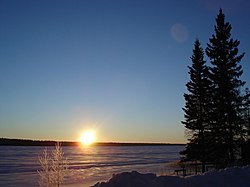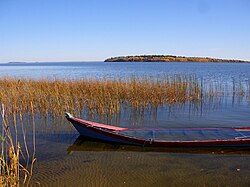
This is a list of lakes of Saskatchewan , a province of Canada. The largest and most notable lakes are listed at the start, followed by an alphabetical listing of other lakes of the province. [1] [2]

This is a list of lakes of Saskatchewan , a province of Canada. The largest and most notable lakes are listed at the start, followed by an alphabetical listing of other lakes of the province. [1] [2]
"The total area of a lake includes the area of islands. Lakes lying across provincial boundaries are listed in the province with the greater lake area." [3]
| Lake | Area (includes islands) | Altitude | Depth max. | Volume |
|---|---|---|---|---|
| Lake Athabasca [4] | 7,935 km2 (3,064 sq mi) | 213 m (699 ft) | 124 m (407 ft) | 204 km3 (49 cu mi) |
| Reindeer Lake [4] | 6,650 km2 (2,570 sq mi) | 337 m (1,106 ft) | 219 m (719 ft) | 95.25 km3 (22.85 cu mi) |
| Wollaston Lake [4] | 2,681 km2 (1,035 sq mi) | 398 m (1,306 ft) | 97 m (318 ft) | 39.8 km3 (9.5 cu mi) |
| Cree Lake [4] | 1,434 km2 (554 sq mi) | 487 m (1,598 ft) | 60 m (200 ft) | 17.6 km3 (4.2 cu mi) |
| Lac la Ronge [4] | 1,413 km2 (546 sq mi) | 364 m (1,194 ft) | 42.1 m (138 ft) | 17.6 km3 (4.2 cu mi) |
| Peter Pond Lake [4] | 778 km2 (300 sq mi) | 421 m (1,381 ft) | 24 m (79 ft) | 10.6 km3 (2.5 cu mi) |
| Doré Lake [4] | 640 km2 (250 sq mi) | 459 m (1,506 ft) | 20.4 m (67 ft) | 6.68 km3 (1.60 cu mi) |
| Churchill Lake [5] | 559 km2 (216 sq mi) | 421 m (1,381 ft) | 24 m (79 ft) | 4.88 km3 (1.17 cu mi) |
| Deschambault Lake [6] | 542 km2 (209 sq mi) | 324 m (1,063 ft) | 22.4 m (73 ft) | 3.35 km3 (0.80 cu mi) |
| Frobisher Lake [7] | 516 km2 (199 sq mi) | 421 m (1,381 ft) | 19 m (62 ft) | 2.18 km3 (0.52 cu mi) |
| Black Lake [3] | 464 km2 (179 sq mi) | 281 m (922 ft) | ||
| Montreal Lake [3] | 454 km2 (175 sq mi) | 490 m (1,610 ft) | ||
| Primrose Lake [3] | 448 km2 (173 sq mi) | 599 m (1,965 ft) | ||
| Amisk Lake [3] | 430 km2 (170 sq mi) | 294 m (965 ft) | ||
| Lake Diefenbaker [8] | 430 km2 (170 sq mi) | 556.8 m (1,827 ft) | 66 m (217 ft) | 9.4 km3 (2.3 cu mi) |
| Pinehouse Lake [3] | 404 km2 (156 sq mi) | 384 m (1,260 ft) |








